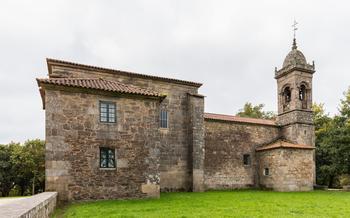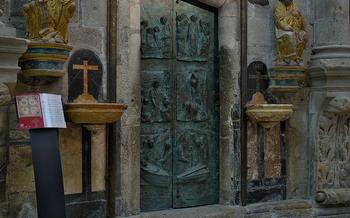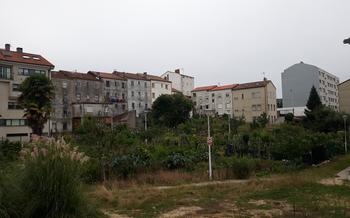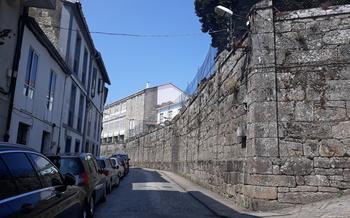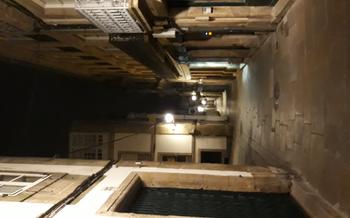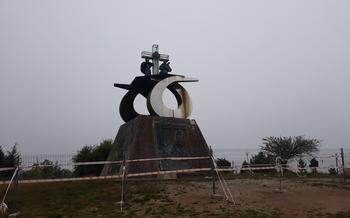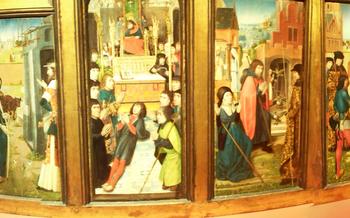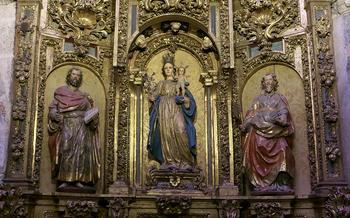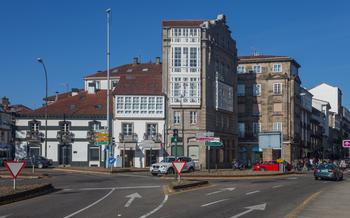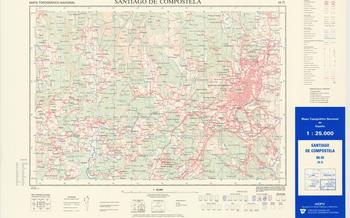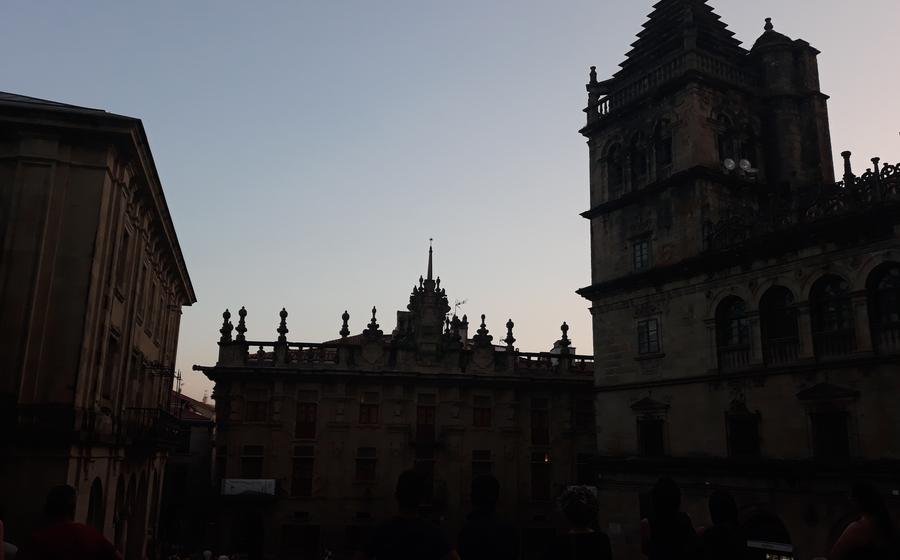
Colegio de Fonseca Historic college building
- History of the Colegio de Fonseca
- Location of the Colegio de Fonseca
- The Colegio de Fonseca Today
- Visiting the Colegio de Fonseca
- Patio de Fonseca
- Sala de Juntas
- Capilla de Fonseca
- Biblioteca Fonseca
- Museo das Peregrinacións
- Taking a Guided Tour
- Pilgrim Credential Stamp
- Attending Events and Workshops
- Accessibility for Visitors
- Insider Tip: Hidden Gem
History of the Colegio de Fonseca
The Colegio de Fonseca is a historic college building in Santiago de Compostela, Spain. It was founded in 1522 by Archbishop Alonso de Fonseca III, who intended it to be a center of higher learning for the study of theology, law, and medicine. The college was built on the site of a former hospital, and its construction was completed in 154
The Colegio de Fonseca is a significant historical landmark in Santiago de Compostela, and it has played an important role in the city's educational and cultural development. It was one of the first institutions of higher learning in Spain, and it has been home to some of the country's most renowned scholars and intellectuals. The college is also a UNESCO World Heritage Site, and it is one of the most visited tourist attractions in Santiago de Compostela.
The Colegio de Fonseca is an impressive example of Renaissance architecture. Its main facade is adorned with intricate carvings, and its interior courtyards and cloisters are decorated with beautiful frescoes and sculptures. The college is also home to a number of important works of art, including a collection of paintings by El Greco.
Location of the Colegio de Fonseca
The Colegio de Fonseca is strategically situated in the heart of Santiago de Compostela, a city renowned for its historical significance and vibrant cultural scene. Its exact address is Rúa do Franco, 12, 15704 Santiago de Compostela, Spain.
To reach this architectural gem, visitors can embark on a leisurely stroll through the city's enchanting streets, allowing themselves to be captivated by the charm of its medieval architecture and vibrant atmosphere. Alternatively, they can opt for the convenience of public transportation, with several bus lines conveniently stopping nearby.
Once you arrive in the vicinity of the Colegio de Fonseca, you'll find yourself surrounded by an array of captivating attractions that beckon you to explore. The majestic Santiago Cathedral, a UNESCO World Heritage Site and the spiritual heart of the city, stands tall just a stone's throw away. The lively Plaza del Obradoiro, with its bustling cafes and vibrant atmosphere, is also within easy reach.
Whether you choose to wander on foot or utilize public transportation, the Colegio de Fonseca's prime location ensures that it is effortlessly accessible to visitors from all corners of the globe.
The Colegio de Fonseca Today
The Colegio de Fonseca has undergone several transformations and renovations throughout its history. Today, it serves as a vibrant cultural hub, housing various educational and cultural institutions.
The college's main building, with its iconic facade and interior courtyards, has been meticulously restored and now houses the Museo de las Peregrinaciones (Pilgrimage Museum) and the Biblioteca Fonseca (Fonseca Library). The museum offers a fascinating journey through the rich history and cultural significance of the Camino de Santiago, showcasing artifacts, interactive displays, and personal accounts of pilgrims from across the centuries.
The Biblioteca Fonseca, on the other hand, is a treasure trove of knowledge, boasting a vast collection of rare books, manuscripts, and historical documents. It serves as a vital resource for researchers and scholars, providing a tranquil space for study and contemplation.
In addition to these institutions, the Colegio de Fonseca also hosts a variety of cultural events, workshops, and exhibitions throughout the year. These events range from traditional Galician music concerts and art exhibitions to lectures and conferences on various academic and cultural topics.
The ongoing restoration efforts at the Colegio de Fonseca are a testament to the commitment to preserving its architectural heritage while adapting it to modern needs. The college's transformation into a dynamic cultural center has breathed new life into this historic institution, ensuring its relevance and vibrancy in the 21st century.
Visiting the Colegio de Fonseca
The Colegio de Fonseca is open to the public and offers a variety of ways to explore its rich history and architecture.
Opening hours and admission fees:
The college is open from Tuesday to Sunday, with varying hours depending on the season. Admission fees are very reasonable, with discounts for students and seniors.
Guided tours and self-guided exploration:
Guided tours are available in English and Spanish, and provide an in-depth look at the college's history and highlights. Visitors can also choose to explore the college at their own pace, using a self-guided audio tour or simply wandering through the grounds.
Highlights not to miss:
Some of the highlights of the Colegio de Fonseca that visitors should not miss include:
-
The Patio de Fonseca, a beautiful central courtyard with a fountain and surrounded by elegant arcades.
-
The Capilla de Fonseca, the college's chapel, which features a stunning altarpiece and other religious artworks.
-
The Biblioteca Fonseca, a historic library with a collection of rare books and manuscripts.
-
The Museo das Peregrinacións, a museum dedicated to the history of pilgrimages, with interactive displays and artifacts.
Patio de Fonseca
At the heart of the Colegio de Fonseca lies the Patio de Fonseca, a stunning central courtyard that serves as a testament to the architectural grandeur of the Renaissance period. Surrounded by elegant two-story galleries, the patio exudes an atmosphere of serenity and contemplation, inviting visitors to pause and admire its intricate details.
The arcaded galleries, supported by slender columns, create a rhythmic pattern that adds visual interest to the courtyard. The arches are adorned with intricate carvings and moldings, showcasing the exceptional craftsmanship of the era. The galleries provide access to the various rooms and offices of the college, adding a functional aspect to the courtyard's design.
In the center of the patio, a beautiful fountain adds a touch of tranquility to the space. The fountain, adorned with intricate carvings and spouting water from multiple spouts, provides a soothing backdrop for visitors to relax and enjoy the ambiance of the courtyard.
The surrounding buildings, with their harmonious blend of Renaissance and Gothic architectural elements, further enhance the beauty of the Patio de Fonseca. The facades are adorned with decorative elements such as pilasters, cornices, and medallions, creating a visually captivating ensemble.
Overall, the Patio de Fonseca is a masterpiece of Renaissance architecture, showcasing the harmonious integration of form and function. Its serene atmosphere, intricate details, and surrounding buildings make it a highlight of the Colegio de Fonseca and a must-see for visitors.
Sala de Juntas
The Sala de Juntas, or assembly hall, is the main meeting room of the Colegio de Fonseca. It is a spacious and elegant room, with a high ceiling and large windows that let in plenty of natural light. The walls are lined with portraits of former rectors and other notable figures associated with the college.
The Sala de Juntas has been used for a variety of purposes over the years, including meetings, lectures, and conferences. It has also been used for more formal occasions, such as the signing of treaties and other important documents.
One of the most notable features of the Sala de Juntas is its ceiling. The ceiling is decorated with a series of frescoes that depict scenes from the life of Saint James the Great, the patron saint of Spain. The frescoes were painted by the Spanish artist Francisco de Goya in the 18th century.
The Sala de Juntas is a beautiful and historic room that is well worth a visit. It is a reminder of the important role that the Colegio de Fonseca has played in the history of Santiago de Compostela.
Capilla de Fonseca
The Capilla de Fonseca, or Fonseca Chapel, is the spiritual heart of the Colegio de Fonseca. It was built in the 16th century and is a prime example of Renaissance architecture. The chapel features a stunning altarpiece carved from alabaster and polychrome wood. The altarpiece depicts scenes from the life of Christ and the Virgin Mary, and is attributed to the renowned sculptor Juan de Juni. The chapel also houses several other religious artworks, including paintings and sculptures from the 16th and 17th centuries.
One of the highlights of the chapel is its stained glass windows, which depict various scenes from the Bible. The windows were created by Flemish artisans and are considered to be among the finest examples of stained glass in Spain. The Capilla de Fonseca is a place of great beauty and tranquility, and is a must-see for anyone interested in religious art or history. Visitors can attend mass in the chapel, which is held daily at noon.
Biblioteca Fonseca
The Biblioteca Fonseca is the historic library of the Colegio de Fonseca and one of the most significant libraries in Galicia. It was founded in 1528 by Archbishop Fonseca and has been in continuous operation ever since, making it one of the oldest libraries in Spain. The library's collection includes over 90,000 volumes, many of which are rare and valuable books and manuscripts. Among the highlights of the collection are incunabula (books printed before 1501), medieval manuscripts, and early printed books on a wide range of subjects, including theology, philosophy, science, and literature. The library also houses a collection of over 1,000 manuscripts, including the Codex Calixtinus, a 12th-century manuscript that is one of the most important sources of information on the Camino de Santiago.
The Biblioteca Fonseca is a working library, and researchers from all over the world come to consult its collection. The library also offers a variety of services to visitors, including guided tours, exhibitions, and lectures. The library is open to the public Monday through Friday, and admission is free.
Museo das Peregrinacións
Enriched by centuries of pilgrimage, Santiago of the Colegio de Fonseca, you'll find a treasure trove dedicated to the fascinating world of pilgrimages – the Museo das Peregrinacións.
Step into this intriguing museum, and you'll be transported to a realm where the spirit of pilgrimage comes alive. Through immersive exhibitions, interactive displays, and a collection of artifacts, the museum unveils the stories of countless pilgrims who have journeyed to Santiago de Compostela over the centuries.
Discover the various pilgrim routes that crisscross Europe, each with its own challenges and rewards. Learn about the motivations and experiences of pilgrims from different eras, from devout believers to adventurers seeking a transformative journey.
The museum also showcases the profound impact of pilgrimage on art, literature, and music. Admire medieval manuscripts adorned with intricate illustrations of pilgrim life, and listen to traditional songs that capture the essence of the pilgrimage experience.
One of the highlights of the museum is the collection of pilgrim credentials, or "credenciales." These small booklets were carried by pilgrims as they traveled, serving as a record of their journey and a way to receive hospitality along the way.
As you wander through the exhibits, you'll gain a deep appreciation for the enduring legacy of pilgrimage. Whether you're a pilgrim yourself or simply curious about this ancient tradition, the Museo das Peregrinacións offers an unforgettable journey into the heart of the pilgrimage experience.
Taking a Guided Tour
Guided tours of the Colegio de Fonseca offer an enriching and informative experience for visitors. Led by knowledgeable guides, these tours provide insights into the history, architecture, and significance of the college. Guides share anecdotes and stories, bringing the past to life and helping visitors connect with the rich heritage of the institution.
Booking Information and Availability: Guided tours can be booked online or at the tourist information office in Santiago de Compostela. Tours are available in several languages, including English, Spanish, and French. Tours are typically conducted on a daily basis, with morning and afternoon slots. Advance booking is recommended, especially during peak tourist season.
Languages Offered and Group Sizes: Guided tours are available in multiple languages to cater to international visitors. Groups are typically small, allowing for personalized attention and interaction with the guide. Group sizes may vary depending on the tour operator and the time of year.
Pilgrim Credential Stamp
Pilgrims walking the Camino de Santiago can obtain a special stamp at the Colegio de Fonseca to mark their journey. This stamp is highly sought after by pilgrims as it serves as proof of their pilgrimage and can be used to obtain the Compostela certificate, a document that certifies the completion of the pilgrimage. The stamp office is located in the courtyard of the college, and pilgrims can easily obtain the stamp by presenting their pilgrim credential, or credential. The stamp office is open during regular business hours, and there is no charge for obtaining the stamp.
Attending Events and Workshops
The Colegio de Fonseca is not just a historical monument but also a vibrant cultural center. Throughout the year, the college hosts a variety of events and workshops that are open to the public. These events celebrate the rich cultural heritage of Santiago de Compostela and offer visitors a chance to engage with the local community.
Music concerts, art exhibitions, lectures, and workshops are just a few of the events that take place at the college. These events provide a platform for local artists and scholars to showcase their work and share their knowledge with the public. Visitors can attend concerts featuring traditional Galician music, admire stunning artworks by contemporary artists, or learn about the history and culture of Santiago de Compostela through informative lectures.
To find out about upcoming events and workshops, visitors can check the college's official website or social media pages. The events are usually free of charge or have a small admission fee. By attending these events, visitors can not only explore the Colegio de Fonseca's cultural offerings but also immerse themselves in the vibrant atmosphere of Santiago de Compostela.
Accessibility for Visitors
The Colegio de Fonseca is committed to providing an inclusive and accessible environment for all visitors. Wheelchair ramps and elevators are available throughout the college, ensuring that visitors with physical disabilities can easily navigate the building. Adapted tours and services are also offered upon request, allowing visitors with disabilities to fully enjoy the college's rich history and cultural offerings. The staff at the college is always happy to assist visitors with any accessibility needs they may have, ensuring that everyone has a positive and memorable experience.
Insider Tip: Hidden Gem
Beyond the main attractions, the Colegio de Fonseca holds a hidden gem that often goes unnoticed by visitors. Tucked away on the upper floor of the college, you'll find a small, secluded room known as the "Sala de los Arcos." This hidden chamber is a testament to the college's rich history and architectural heritage.
To find the Sala de los Arcos, ascend the grand staircase to the second floor and follow the corridor to the far end. Here, you'll discover an unassuming wooden door that leads to this hidden treasure. Step inside, and you'll be greeted by a breathtaking sight—a beautifully preserved room adorned with intricate Mudejar-style arches.
The Sala de los Arcos was once used as a meeting room for the college's governing body. Today, it serves as a tranquil retreat where visitors can escape the hustle and bustle of the city and delve into the college's past. The room's serene atmosphere and stunning architectural details make it an ideal spot for contemplation and reflection.
Whether you're a history buff, an architecture enthusiast, or simply someone seeking a hidden gem, the Sala de los Arcos is a must-visit. Its unique charm and historical significance make it a truly special place that few visitors get to experience.
